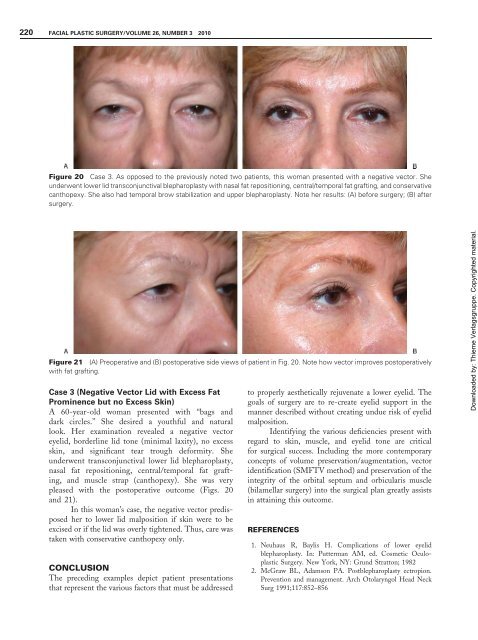Comprehensive Lower Eyelid Rejuvenation - Dr. Guy Massry
Comprehensive Lower Eyelid Rejuvenation - Dr. Guy Massry
Comprehensive Lower Eyelid Rejuvenation - Dr. Guy Massry
You also want an ePaper? Increase the reach of your titles
YUMPU automatically turns print PDFs into web optimized ePapers that Google loves.
220 FACIAL PLASTIC SURGERY/VOLUME 26, NUMBER 3 2010<br />
Figure 20 Case 3. As opposed to the previously noted two patients, this woman presented with a negative vector. She<br />
underwent lower lid transconjunctival blepharoplasty with nasal fat repositioning, central/temporal fat grafting, and conservative<br />
canthopexy. She also had temporal brow stabilization and upper blepharoplasty. Note her results: (A) before surgery; (B) after<br />
surgery.<br />
Figure 21 (A) Preoperative and (B) postoperative side views of patient in Fig. 20. Note how vector improves postoperatively<br />
with fat grafting.<br />
Case 3 (Negative Vector Lid with Excess Fat<br />
Prominence but no Excess Skin)<br />
A 60-year-old woman presented with ‘‘bags and<br />
dark circles.’’ She desired a youthful and natural<br />
look. Her examination revealed a negative vector<br />
eyelid, borderline lid tone (minimal laxity), no excess<br />
skin, and significant tear trough deformity. She<br />
underwent transconjunctival lower lid blepharoplasty,<br />
nasal fat repositioning, central/temporal fat grafting,<br />
and muscle strap (canthopexy). She was very<br />
pleased with the postoperative outcome (Figs. 20<br />
and 21).<br />
In this woman’s case, the negative vector predisposed<br />
her to lower lid malposition if skin were to be<br />
excised or if the lid was overly tightened. Thus, care was<br />
taken with conservative canthopexy only.<br />
CONCLUSION<br />
The preceding examples depict patient presentations<br />
that represent the various factors that must be addressed<br />
to properly aesthetically rejuvenate a lower eyelid. The<br />
goals of surgery are to re-create eyelid support in the<br />
manner described without creating undue risk of eyelid<br />
malposition.<br />
Identifying the various deficiencies present with<br />
regard to skin, muscle, and eyelid tone are critical<br />
for surgical success. Including the more contemporary<br />
concepts of volume preservation/augmentation, vector<br />
identification (SMFTV method) and preservation of the<br />
integrity of the orbital septum and orbicularis muscle<br />
(bilamellar surgery) into the surgical plan greatly assists<br />
in attaining this outcome.<br />
REFERENCES<br />
1. Neuhaus R, Baylis H. Complications of lower eyelid<br />
blepharoplasty. In: Putterman AM, ed. Cosmetic Oculoplastic<br />
Surgery. New York, NY: Grund Stratton; 1982<br />
2. McGraw BL, Adamson PA. Postblepharoplasty ectropion.<br />
Prevention and management. Arch Otolaryngol Head Neck<br />
Surg 1991;117:852–856<br />
Downloaded by: Thieme Verlagsgruppe. Copyrighted material.


